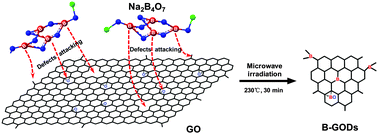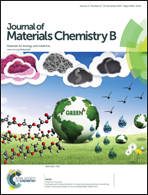An acid-free microwave approach to prepare highly luminescent boron-doped graphene quantum dots for cell imaging
Abstract
Boron-doped graphene quantum dots (B-GQDs) are prepared via a one-pot acid-free microwave approach with graphene oxide as the carbon source and borax as the boron source. Boron atoms are incorporated into the graphene framework by attacking the defects in the graphene structure, deriving an atomic percentage of 1.44% in the final product. Boron atom doping into the graphene structure and restoration of defects in the graphene structure bring the obtained B-GQDs favorable photoluminescence behaviors. The as-prepared B-GQDs exhibit excitation-independent photoluminescence behaviors with an excitation/emission maximum at 320/430 nm, and a fluorescence quantum yield of 21.1%. Moreover, stable photoluminescence is observed within a wide range of pH 3.0–11.0. A tolerance to an external ionic strength of up to 2.0 mol L−1 KCl along with an excellent anti-photobleaching capability is achieved. The standard MTT assay suggests that the B-GQDs are of low cytotoxicity with favorable biocompatibility, and a cell viability of 87% could be achieved at 4.0 mg mL−1 of B-GQDs. The practical application of B-GQDs in bio-analysis is demonstrated by bio-imaging of HeLa cells.


 Please wait while we load your content...
Please wait while we load your content...